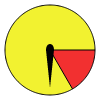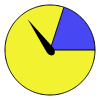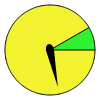Scroll:Probability >> More, less and equally likely >> mcq (3913)
Written Instructions:
For each Multiple Choice Question (MCQ), four options are given. One of them is the correct answer. Make your choice (1,2,3 or 4). Write your answers in the brackets provided..
For each Short Answer Question(SAQ) and Long Answer Question(LAQ), write your answers in the blanks provided.
Leave your answers in the simplest form or correct to two decimal places.
| 1) On which colour is the spinner less likely to land
( ) |
| 2) On which colour is the spinner more likely to land
( ) |
| 3) On which colour is the spinner less likely to land
( ) |
| 4) On which colour is the spinner less likely to land
( ) |
| 5) If you select a marble without looking, which colour are you more likely to pick
( ) |
| 6) On which colour is the spinner less likely to land
( ) |
| 7) On which colour is the spinner less likely to land
( ) |
| 8) If you select a marble without looking, which colour are you more likely to pick
( ) |
| 9) On which colour is the spinner more likely to land
( ) |
| 10) On which colour is the spinner less likely to land
( ) |
| 1) On which colour is the spinner less likely to land
Answer: 2 SOLUTION 1 : Look at the spinner. The red part is smaller than the blue part. Less of the spinner is red than is blue. The spinner is less likely to land on red. |
| 2) On which colour is the spinner more likely to land
Answer: 2 SOLUTION 1 : Look at the spinner. The red part is smaller than the yellow part. more of the spinner is yellow than is red. The spinner is more likely to land on yellow. |
| 3) On which colour is the spinner less likely to land
Answer: 2 SOLUTION 1 : Look at the spinner. The green part is smaller than the blue part. Less of the spinner is green than is blue. The spinner is less likely to land on green. |
| 4) On which colour is the spinner less likely to land
Answer: 1 SOLUTION 1 : Look at the spinner. The blue part is smaller than the yellow part. Less of the spinner is blue than is yellow. The spinner is less likely to land on blue. |
| 5) If you select a marble without looking, which colour are you more likely to pick
Answer: 1 SOLUTION 1 : First, count the yellow marbles. There is 3 yellow marbles.
There are more red marbles. You are more likely to pick red.
|
| 6) On which colour is the spinner less likely to land
Answer: 2 SOLUTION 1 : Look at the spinner. The yellow part is smaller than the blue part. Less of the spinner is green than is blue. The spinner is less likely to land on green. |
| 7) On which colour is the spinner less likely to land
Answer: 1 SOLUTION 1 : Look at the spinner. The green part is smaller than the yellow part. Less of the spinner is green than is yellow. The spinner is less likely to land on green. |
| 8) If you select a marble without looking, which colour are you more likely to pick
Answer: 2 SOLUTION 1 : First, count the brown marbles. There is 3 brown marbles.
There are more brown marbles. You are more likely to pick brown.
|
| 9) On which colour is the spinner more likely to land
Answer: 1 SOLUTION 1 : Look at the spinner. The yellow part is smaller than the green part. more of the spinner is green than is yellow. The spinner is more likely to land on green. |
| 10) On which colour is the spinner less likely to land
Answer: 2 SOLUTION 1 : Look at the spinner. The blue green is smaller than the yellow part. Less of the spinner is green than is yellow. The spinner is less likely to land on green. |









